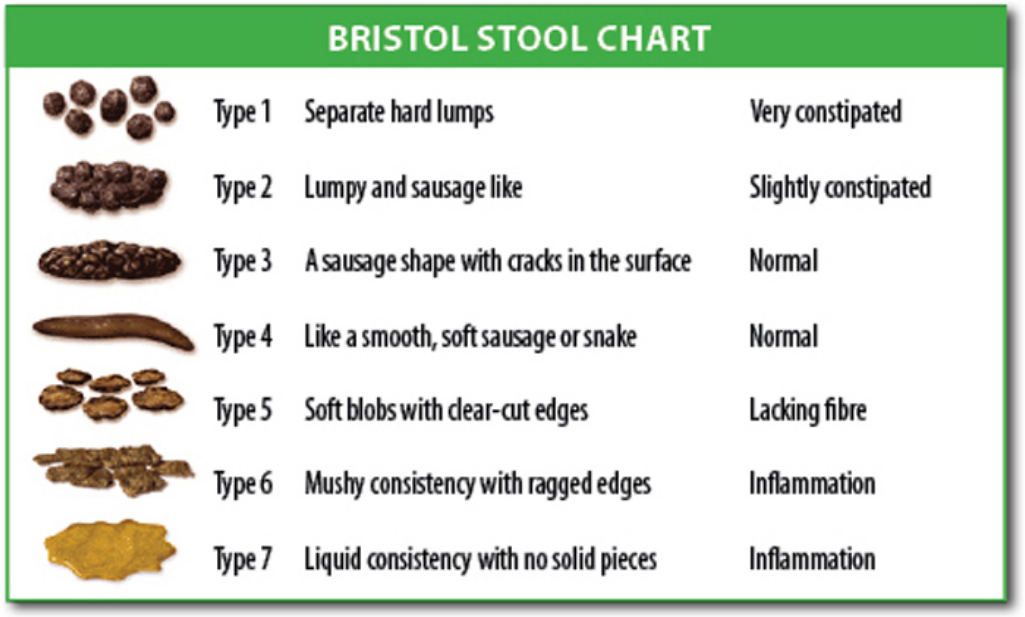
What Does The Shape And Texture Of My Poop Mean
Bristol Stool Chart – 7 Types Of Stools
Your poop in the toilet bowl is basically the result of your diet, fluids, medications and lifestyle.
The Bristol Stool Chart is a medical aid designed to classify stools into 7 groups. The type of stool you pass out depends on the time it spends in your colon. What you see in the toilet bowl is basically the result of your diet, fluids, medications and lifestyle.

Many people are unaware that their poo could be a big indicator toward the state of their health. Whether it pertains to digestion, continence, constipation or diarrhoea, our bowel health plays a vital role towards maintaining our general health and well being.
For instance, constipation is a common problem but the condition is often dismissed, or even laughed off. But if left untreated, constipation can lead to more serious health problems.
In fact, a recent British study on constipation has revealed that bowel health was second in the list of embarrassing things to talk to your doctor about – 19 per cent, topped only by sexually transmitted infections – 35 per cent.
Type 1: Hard Pebble Poop
Separate hard lumps of poop, similar to pebbles.
This kind of stool is painful to pass out. It has sat in the large intestine and colon for an extended period of time.
Verdict: Very constipated
Type 2: Firm Poop
Lumpy and sausage-like poop that is connected together.
This poop has spent too much time drying in the intestines, but has not dried out enough to break apart into smaller pieces.
Verdict: Slightly constipated
Type 3: Cracked Poop
A sausage shape poop with cracks in the surface.
This kind of stool is most often seen with organic constipation – constipation caused by a sedentary lifestyle or a poor diet. Passing out this stool is not painful, but straining is required.
Verdict: Normal
Type 4: Healthy Poop
Poop resembling a smooth, soft sausage or snake.
Heathy stool remains intact upon flushing, indicating a optimal amount of water and nutrients in it. It resembles a soft-serve ice cream with the diameter of a banana.
Verdict: Normal
Type 5: Soft Blob Poop
Soft blobs of poop with clear-cut edges.
This slightly loose stool comes in the form of soft blobs with defined edges. This form of bowel movement is common for individuals who pass motion 2 to 3 times every day – usually after the major meals of the day.
Verdict: Lacking fibre
Type 6: Mushy Poop
Poop with mushy consistency and with ragged edges.
Mushy stool with fluffy pieces that run together into a pudding-like consistency is an early sign of diarrhoea. It is often difficult to control the urge or timing of the bowel movement. This form of stool has passed through the colon quickly, often as a result of the individual’s high stress level, or caused by a dramatic change in diet or activity level.
Verdict: Inflammation
Type 7: Liquid Poop
Liquid consistency with no solid pieces.
The most advanced stage of diarrhoea, liquid poop has no solid form and passes without control. Diarrhoea occurs when the small intestine is irritated, forcing the liquid into the small intestine to flush out of the body without being properly processed. Liquid can be absorbed by the large intestine, but most pools in the rectum, causing explosive diarrhoea that is uncontrollable.
Verdict: Inflammation

Get In Touch
Contact us today for dependable solutions to all your plumbing and electrical needs.